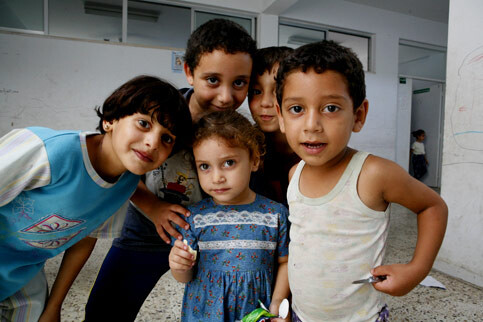Beirut 19 July 2007

After being forced from their homes in Nahr al-Bared, Palestinian refugees are now living in Baddawi refugee camp. Here children from Nahr al-Bared play in the hallways of a UN school where many families are currently living, 19 July 2007. (Matthew Cassel)
It’s difficult for me to live in Lebanon and not be conscious of space and time. The space around me when I’m in an enclosed space like a refugee camp or facing the openness of the Mediterranean Sea along the Corniche or examining the changed landscape of Beirut peppered among the high-rise skyscrapers and bullet-pocked buildings from the Civil War. Those scars on the buildings in Beirut are as ever present whether you are in the city or in a refugee camp, some places more ravaged than others. It is especially difficult to move back and forth among these spaces from Shatila refugee camp with its children playing within a confined asphalt jungle to the beach where children run free in spaces without walls.
The overcrowded, densely populated Baddawi refugee camp, filled with double its population, where people are trapped inside for fear of harassment at a checkpoint, is a constant reminder of my spatial surroundings. The recent arrivals in Baddawi, those who fled Nahr al-Bared last week, shared stories with me of what their space has been like for them the past several weeks. They were among the 150-200 Palestinians who fled in this latest, though slight, lull in the army’s bombardment of the refugee camp. As has become the custom, teenage boys and men were rounded up and detained by the army. There were photographs of devastating destruction of the homes and community spaces in the camp, of the people who have been injured from the army’s siege — men, women, and children alike. The buildings are so destroyed that one cannot see people’s effects remaining. Instead, one sees the few buildings that remain without walls and floors angled to the ground below, everything having slid down to the ground. One sees the Lebanese army and Fatah al-Islam fighting in the narrow alleys of the camp. One sees not just fragments of buildings, but lives that were lost, communities that were ruined.
These stories of ruin — of lives and spaces — build on the calamities of the past, calamities of Nahr al-Bared now and of a few weeks ago, of Palestinians fleeing the massacre in Tel al-Za’atar refugee camp in 1976 to the safety of Nahr al-Bared, of the original nakba (catastrophe) in 1948 when the first generation was removed and dispersed from Palestine. These stories are compounded. These experiences and the wrought history contained within them leave people feeling anxious and wondering just how long they can live in such a tight, compressed space where the women have no privacy to take showers, where the children have no space to hold a proper soccer match, where the men feel imprisoned for fear of leaving Baddawi though the need for work and getting on with one’s daily life is great.
These images and stories recall past wars on Palestinian camps in Lebanon and in occupied Palestine. I was sitting with a friend of mine in Shatila who lived through both the invasion of the Israelis/Phalangist movement and the Amal movement in the 1980s the other day when a man from Nahr al-Bared walked into his office. He was in anguish over all he has lost in the camp — not his home and thankfully not his family, but his photographs, they key to his family’s home in Palestine. Reminders of one’s spatial history and communities. My friend, whose home in Shatila was destroyed in the war of the camps in the 1980s, began to consider all that he lost from his family’s home in Palestine, to loved ones during the camp battles in Beirut, to the objects connecting him to these stories and experiences. Speaking quietly, he offered, “If only I had at least one photograph of myself from before 1967 …” If only.
It is this past, which may not be represented in photographs any longer as they became and become ashes, that directly informs the fears of Palestinians who want their communities back, if only until al-awda (the right of return to Palestine). If only.
Dr. Marcy Newman is a Visiting Professor at the Center for American Studies and Research at the American University of Beirut and a Fellow at the Initiative for Middle East Policy Dialogue. She is also a coordinator for the Nahr el Bared Relief Campaign (www.nahrelbaredcampaign.org). For more information please email Marcy Newman at marcynewman at gmail.com.





